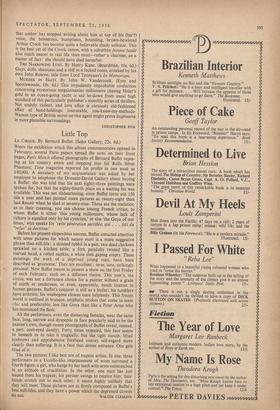Little Top
WHEN the exhibition which this album commemorates opened in February, several Paris papers spread the news on their front pages; Paris Match offered photographs of Bernard Buffet repos- ing at his country estate and stepping into his Rolls Silver Phantom; Time magazine reported his profits in one week as £40,000. A secretary of my acquaintance was asked by her employer to telephone the Drouant-David Gallery about buying a Buffet; she was told that his next eighty-three paintings were spoken for, but that the eighty-fourth place on a waiting list was available. This was not disheartening, since Buffet turns out 150 oils a year and has painted more pictures at twenty-eight than had Renoir when he died at seventy-nine. Those are the statistics; as to their meaning, you can choose among French critics, to whom Buffet is either 'this young millionaire, whose lack of culture is equalled only by his cynicism,' or else 'the Goya of our times,' who speaks for 'cette generation sacrifiee, qui . . . fait du "ref us" sa doctrine.'
Before his present stupendous success, Buffet attracted attention with some pictures for which nature mort is a more suggestive phrase than still-life : a skinned rabbit in a pan; two dead chickens sprawled on a kitchen table; a fork painfully twisted like a starved hand, a rolled napkin, a white dish gaping empty. These paintings, the work of a deprived young man, have been described as 'gruesome.' They are excellent : terse, sure, strikingly personal. Now Buffet means to present a show on the first Friday of each February, each on a different theme. This year's, the circus, was not a fortunate choice for a painter without a grain of mirth or tenderness, or even, apparently, much interest in human gestures. Buffet's conjurer is stiff as a butler; his tumblers have arthritis; his woebegone clowns stare helplessly. This frozen world is outlined in brusque, emphatic strokes that come to seem chic and predictable; less like Goya than like a Peter Arno who has renounced the flesh.
All the performers, even the dismaying females, wear the same face, long, narrow and dyspeptic (a face popularly said to be the painter's own, though recent photographs of Buffet reveal, instead, a pert, cool-eyed dandy). Forty times repeated, this face seems to beseech us to take it tragically, but the tight mouth, lifted eyebrows and apprehensive forehead convey self-regard more clearly than suffering. It is a face that denies entrance. One gets tired of it.
The two pictures I like best are of trapeze artists. In one, three performers in a Uccello-like imprisonment of wires surround a fourth figure, a girl, who hangs by her teeth with arms outstretched in an attitude of crucifixion. In the other, one man has just leaped from his trapeze; his partner swings to receive him; their hands stretch out to each other; it seems highly unlikely that they will meet. These pictures are as firmly composed as Buffet's best still-lifes, and they have a power which the depressed clowns
do not. WALTER CLEMONS


































 Previous page
Previous page